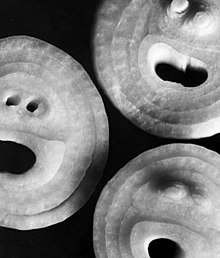New vision

The New Seeing (also: New Optics ) is a specific style in photography that developed in the 1920s. The new way of seeing is often mentioned in the same breath as photography at the Bauhaus . The imagery of the New Vision aims to loosen up stuck structures in terms of composition and lighting or exposure of photography. Instead, a dynamic orientation is postulated that adapts to social progress and is able to document it accordingly.
style
Before the First World War , photography changed. Proximity to painting was no longer sought ( pictorialism ), but the reversal to so-called straight photography - or direct photography - was made. From this very objective approach (see also Neue Sachlichkeit ), the desire arose at the beginning of the 1920s to be able to record the social upheavals in an optimistic and dynamic manner. The new way of seeing, the result of this idea, explains the so-called navel perspective as insubstantial and interprets the precise illumination of contemporary photographs as an unassuming and bland representation of reality.
Above all, the young Russian constructivists around Alexander Michailowitsch Rodtschenko and the increasing number of photographers at the Bauhaus wanted to perceive their surroundings from interesting perspectives (extreme top or bottom views). They also experimented with light and shadow, which in the end result often led to large, shady parts of the picture. In terms of composition, the New Vision was not committed to any regulations. Rather, creative impulses were applied to the subjects to be depicted in order to create a new interpretation of the reproductive moment in photography.
Overall, New Seeing can be categorized as a very experimental style that is always open to new impulses and does not present itself uniformly. The intention of New Vision is to expand photography from a purely reproductive to a producing medium. A didactic approach can be identified here: the viewer must first be introduced to the new modes of depiction and deal with what is depicted through a perception. For this, familiar subjects are presented to him in an unknown representation.
criticism
The experimental character and the associated inability to express oneself in terms of a uniform style was often criticized for the new vision. The amateur experiments and the apparently lacking technical, photographic training of the photographers of the New Vision were denounced above all by representatives of New Objectivity and straight photography .
With the introduction of pure photography classes at the Bauhaus, this criticism was answered in a certain way, which, however, also led to the fact that the previously extremely creative approach of Bauhaus photography changed to a very factual representation.
Artist
- Irene Bayer
- Aenne Biermann
- Erich Consemüller
- Andreas Feininger
- Hein Gorny
- Arvid Gutschow
- Lucia Moholy
- László Moholy-Nagy
- Walter Peterhans
- Alexander Rodchenko
- Umbo
literature
- Jeannine Fiedler: Photography at the Bauhaus . Berlin, 1990.
- Andreas Haus, Michel Frizot: Stylistic Figures, New Seeing and Photography. In: Michel Frizot (ed.): New history of photography . Cologne, 1998.
- Alexander Rodchenko: Ways of Contemporary Photography. In: Wolfgang Kemp (ed.): Theory of Photography II 1912–1945 . Augsburg, 1979.
- Alexander Rodchenko: essays, autobiographical notes, letters, memories. , Dresden, 1993.